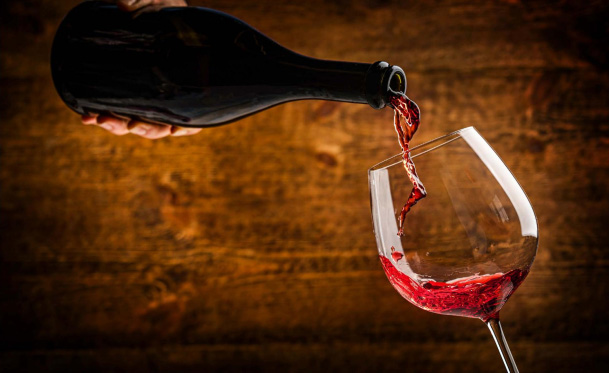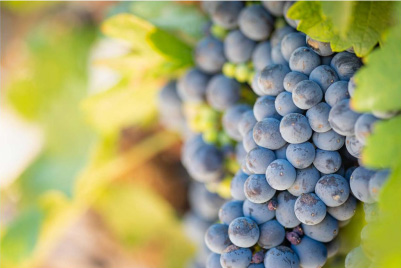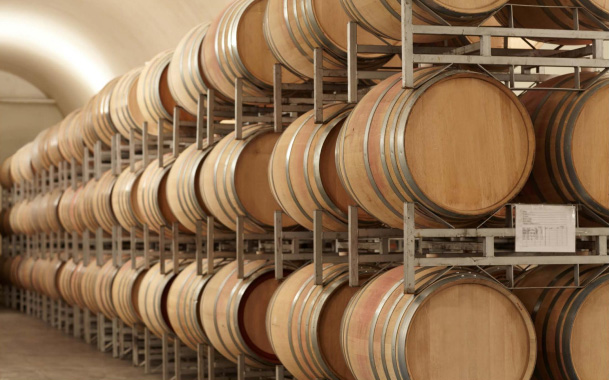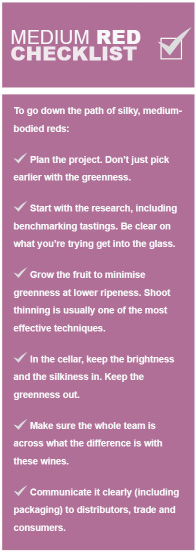By Mark O’Callaghan
Managing Director, Wine Network Consulting, email: mocallaghan@winenet.com.au
In response to the consumer shift away from full-bodied reds to their more medium-bodied counterparts, Mark provides producers with some steps they can take to immediately respond to this increasing demand.

The growing interest in medium bodied reds – at least in Australia – has been steady, relentless and consistent over many years. Of course, that is not to say that all those classically sumptuous, ripe and generous reds have no future – far from it – but while the red wine oversupply continues as a millstone around the neck of the industry overall, managers need to be across the options.
This article is an overview of the sorts of methods that businesses can consider with their current assets and do immediately. It is not about expensive vineyard changes, it certainly doesn’t pretend that grafting the country to Sangiovese is the answer, and nor is it about anything to do with the NoLo category.
Examples of the shift to medium reds abound but one of the most compelling is the incredible growth in Pinot Noir fruit prices (not relevant to all regions, of course) consistently over many years. Another is to look at the shifts in one of the most iconic red wine trophies in the world, the Jimmy Watson. From its inception in the 1960’s until the early 2000s the trophy was dominated – with some notable exceptions – by South Australia but thereafter regular winners appear from Tasmania, Grampians and Mornington Peninsula, including three Pinot Noirs in the last 10 trophies.
For me though, the situation and its impact on business was best summed up by Stephen Strachan from Langley & Co. during the ASVO’s COVID-era webinar series:
“High-end Chardonnay and Pinot Noir from Adelaide Hills, Tasmania, Yarra Valley, Mornington Peninsula and Margaret River – there is very strong demand for that wine and very strong demand for those assets. We have seen steady improvement in asset values in those regions where the China tariffs have really had very little impact.”
Even for businesses and brands with a long pedigree and success with rich reds, they really should consider whether there is a role for making some changes, even if the final answer is ‘no’.
PLAN IT
While there is nothing wrong with a little ad hoc experimentation or trial work per se, the best results are always much more likely when there is a plan, even if it changes. When it comes to playing with wine style – and at the risk of stating the obvious – the first steps are really straightforward. A great place to start is always with well-researched competitors’ tastings. This includes laboratory analysis of the important basics like pH (some results might surprise you) and alcohol, but don’t forget to check dissolved CO2 if you can (more on that later).
Also, seek whatever feedback you can from your sales and marketing teams, key customers, wine show results or wherever you feel you can get trusted, reliable insights suitable to your business. This will tell you a lot about whether the best outcomes are likely to be from finessing an existing blend or introducing a totally new wine with a whole new identity. The last thing anyone needs to do is to go chasing what someone says is the hottest new thing, only to alienate and lose existing customers.
GROW IT

It all starts in the vineyard. Sound familiar? Yet again, that evergreen (pun intended) truism holds because there are so many fundamental aspects to the fruit as it arrives at the winery that determine how suitable a parcel will be to a more medium bodied style. Again, for clarity, expensive overhauls of vineyards, such as changing varieties, are out of scope for this article, so it focuses only on what can be done relatively quickly and affordably with existing plantings.
Greenness is often the killer of wines like this but, as always, there is so much more to fixing it than just picking earlier. The key practices, all of which cost time and money, are all variations on that theme and include the following. In combination, they will enable harvest at lower ripeness without the same green characters.
Shoot and bunch thinning
Shoot thinning is one of my personal favourites. Yes, it takes time but the savings at pruning can be a nice offset, so this is a discussion to be had with growers and/or vineyard managers depending on the particulars of the situation. Certainly, there can be tremendous benefits flowing from the improved canopy structure, but critical to wine style here is the removal of bunches from weak, short or unlignified shoots. One of the most significant tastings from earlier in my career that remains burnt into my palate memory was when some colleagues of mine made trial batch wines from three selective picks within the same vineyard. If you’re having trouble winning the financial arguments, I highly recommend it to make your case: (1) full-length, mature shoots, (2) medium-length shoots, without the same full extension and (3) short, weak, unlignified, green shoots. Unsurprisingly, the quality ranking was as listed above, so nothing revolutionary there but the magnitude of the quality difference was unbelievable. Removing these weaker shoots and bunches has the same effect as not adding, for example, a 3% over-blend of a herbal, green, acidic, watery component to your wine. A similar effect is had by removing secondary bunches, although they can be harder and more time-consuming to find.
Canopy structure
A related topic to explore with your team is that of canopy structure and how modifications might help harvest reds at lower ripeness with less greenness. Work counts prevents and exhaustive discussion of every possible scenario, but over the years I have certainly seen outstanding quality turnarounds from changes, such as allowing a formerly VSP canopy to sprawl, or obvious ones such as leaf plucking. In some cases, it has made good sense to shift the fruiting wire from one side of the trellis post to another (usually within the row) to change the shading effect of the canopy.
Harvesting
One of the most profound practices in the production of fruit for medium-bodied wines is the use of next-generation machine harvesters, which have proven to be one of the very best equipment improvements of recent years. There are few things I hate more than the taste of petioles in red wines, so the ability of these harvesters to leave green, vegetative material behind has been a godsend. Yes, they also cost more per hour to hire, but there are also better ways to save money.
Of course, there are other aspects of viticulture that relate more to vine health that lend themselves to improved tannin ripeness and reduced greenness, such as nutrition, irrigation, soil compaction and trunk diseases, but these topics are intentionally set aside for another day.
MAKE IT
Once fruit arrives at the winery, there is no shortage of options available to specifically improve the results for medium bodies reds. The key drivers of success here usually include some combination of lower alcohol, minimising greenness, a general brightness of fruit, subtle use of oak and with respect to texture, an absence of toughness or chewiness. Once again, not all of these techniques will suit all wines at all times but should be part of pre-vintage planning.
Whole bunches
One of the obvious and occasionally polarising options is the use of whole bunches. This technique is not everyone’s cup of tea and hand picking continues to get more expensive – often prohibitively so – but used judiciously, this helps restrain red wines, making them finer, more focussed and with brighter aromatics. We all know that many of the greatest wines in the world are made with some use of bunches but, again, that doesn’t mean they are appropriate for all brands. As always, the key is balance and using high quality inputs, so be careful if the stems are green and be clear on the outcome you are trying to achieve.
Barrel fermentation
 Related to the use of whole bunches is the option of barrel fermentation. This is not rocket science and certainly not liked by everyone, but can have a lovely effect on fragrance and texture. Often, when whole bunches burst during pressing, the quick release of sugar gives a window of time when the last stages of ferment can be completed in barrel. At a larger scale, there is no reason this cannot be done without whole bunches and the wine pressed early to ferment out the last sugars with oak staves in tank.
Related to the use of whole bunches is the option of barrel fermentation. This is not rocket science and certainly not liked by everyone, but can have a lovely effect on fragrance and texture. Often, when whole bunches burst during pressing, the quick release of sugar gives a window of time when the last stages of ferment can be completed in barrel. At a larger scale, there is no reason this cannot be done without whole bunches and the wine pressed early to ferment out the last sugars with oak staves in tank.
Extraction and oxygen
Early pressing is really just part of the larger theme of more modest extraction that helps deliver the silkiness of texture that can be so appealing when medium-bodies wines are done well. Another technique that might help includes backing off on overall extractive cap management, but I would also recommend analysing seriously how you think you’ll introduce oxygen to active red ferments. The phrasing is deliberate here because so many dubious techniques persist in cellars that people feel introduce oxygen but almost certainly do not. A good way to understand and take control of how much oxygen is put into red ferments is to do it through direct injection. No doubt, venturi systems can be very effective, but compressed air injection (with appropriate filtration of the air) is so much easier to quantify and you will quickly develop a good understanding for what works in your particular circumstances.
Tannins and oak additions
The advice here is as simple as it gets: back off and just don’t overdo it.
Storage temperature
One aspect of maturation that is overlooked more often than one might think is the question of storage temperature. Whether that is in tank, barrel or egg, all wines age faster at higher temperatures. This isn’t rocket science either and we all know it to be true, but when it comes to maintaining primary fruit freshness and retaining dissolved CO2 – especially important for medium-bodied reds – the impact of storage at warmer temperatures over many months can be dreadful. It is the sort of quality erosion that might see a silver medal wine slip to bronze, for example. The great thing, however, is that it is so easily fixed. A simple, cheap way to start is by regularly logging the storage temperature of wines, but that could include within a barrel shed and at different levels. Have you ever measured the temperature difference between the ceiling and floor levels in your barrel shed on a warm day?
Blending
Another option in the cellar that is so incredibly simple is blending. In pursuit of the happy medium, this can include Pinot Noir – as in the increasingly common Light Dry Red (LDR) wines – or adding white wines, the most obvious being Shiraz/Viognier blends. Often maligned after generating some interest in the early 2000s, this is a tool that should still be understood and deployed as required. Last time I looked, Clonakilla was still at the pointy end of the Langton’s classification and that’s not through luck.
Alcohol and additives
At the more tech-focussed end of the options, the options include reverse osmosis (RO) for alcohol reduction which can have an incredible effect on texture. Often misunderstood as simply a brutal tool used only to tackle problems, like Brett or smoke taint, there are some very astute houses out there using RO to finesse wines before bottling. The small alcohol adjustments can work rather like a fining agent to improve texture.
Another newer set of options is found in the range of additives that are remarkably effective in masking green characters and/or filling out the palate to reduce the need for finings. Ideally, the fruit would have been grown to minimise this but, sometimes, needs must.
Destemmers and fruit sorting
One of the most profound improvements in the minimising of green characters in reds – again, enabling lovely wines from earlier picking – is the new generation of destemming and fruit sorting equipment. I’ve sometimes speculated this might be one of the biggest improvements since the pH meter but, regardless, it is game changing. The technology is great and the market competition is fierce, so it continues to improve and there are more suppliers to choose from. If upgrading your clunky old destemmer isn’t in your CAPEX plan, do yourself a favour: call the suppliers immediately and get some quotes.
BOTTLE IT
 When it comes to bottling, to maximise the quality result for medium weight reds there are a few important considerations. First is the question of timing, the effect of which is similar to the storage temperature matter above. By bottling earlier rather than later, this can be a great way to capture more up-front primary fruit characters that give more life and energy to wines like these.
When it comes to bottling, to maximise the quality result for medium weight reds there are a few important considerations. First is the question of timing, the effect of which is similar to the storage temperature matter above. By bottling earlier rather than later, this can be a great way to capture more up-front primary fruit characters that give more life and energy to wines like these.
From a wine chemistry perspective there are then a few parameters that can interact to lift wines and improve texture. This includes dissolved CO2, which may work better at higher levels than richer styles of red, and perhaps lower SO2 levels, depending on the situation.
SELL IT
Perhaps this piece should have started rather than concluded with how the wine would be sold because, in the end, this is what matters: are the customers happy? There are several considerations here that depend very much on the specifics of the business. For example, if this is a new wine in a portfolio of otherwise rich, concentrated reds, a departure in style will need to be made clear to all involved, including the distributor, the cellar door staff and the customers.
Maximising success here may involve planning meetings with the distributor to get them on board, staff training and packaging decisions, including even the choice of language and names beyond just the old Syrah vs Shiraz options and include crystal clear tasting notes, food pairings and realistic drinking windows. The descriptions of the style difference should be clearly understood by everyday wine consumers.
CONCLUSION
Some of the greatest wines of the country – and the world – have been silky-textured, medium bodied styles of red wine, so this is nothing new. What is becoming clear, however, is the enduring nature in the shift of consumer preferences towards them and businesses would be crazy not to take that on board, plan and respond. Medium bodied does not mean medium interest, medium delicious or medium complexity. Grown and made well, these wines can have all the drive, energy and impressive power of the more concentrated styles. And they may just be great for business too.
Published in the Wine & Viticulture Journal, Winter 2024 edition.